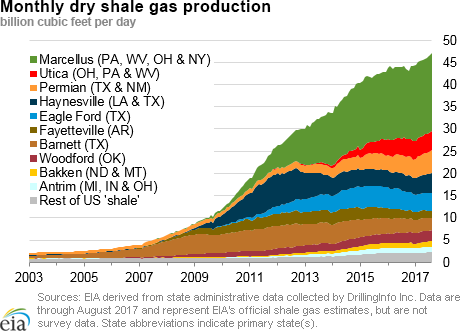In the News:
Puerto Rico’s electricity service is slow to return after Hurricane Maria, leaving LNG imports on hold
Most residents of the U.S. territory of Puerto Rico continue to be without power after extensive damage from Hurricanes Irma and Maria. As of Wednesday morning, 9% of Puerto Rico Electric Power Authority (PREPA) customers have restored service. Portions of Arecibo, Ponce, and Hatillo are partially energized. Other municipalities also partially energized include San Juan, Bayamón, Mayagüez, Carolina, Cataño, and Guaynabo.
The eye of Hurricane Maria, a Category 4 hurricane, made landfall in Puerto Rico on September 20, bringing powerful winds, storm surge, and major flooding. PREPA reported that 1,570,000 of its customers—all of Puerto Rico—were without power that afternoon. Maria destroyed much of the transmission infrastructure on the island, and as a result, outages linger. PREPA expects to have 15% of power restored by October 21.
Puerto Rico relies on fuel imports to meet most of its power generation needs, with nearly half of its generation coming from petroleum products and a third of its generation coming from natural gas. Puerto Rico imports liquefied natural gas (LNG) into the Peñuelas terminal, most of which fuels the EcoEléctricaM and the Costa Sur power plants. Puerto Rico also imports LNG via ISO containers—an estimated 5 million gallons since 2013 . These LNG imports support the territory’s pharmaceutical industry, which produces more than 25% of Puerto Rico’s gross domestic product.
Puerto Rico has been looking to increase natural gas usage to reduce costs and emissions. Prior to the hurricanes, Puerto Rico consumed an average of 0.15 billion cubic feet per day (Bcf/d) of natural gas for power generation. In August 2017, the Federal Energy Regulatory Commission (FERC) approved the expansion of Peñuelas regasification capacity from 186 million cubic feet per day (MMcf/d) to 279 MMcf/d. Once the expansion is complete, 186 MMcf/d of re-gasified LNG will be supplied to the Costa Sur power plant. The remaining 93 MMcf/d will be supplied to EcoEléctrica’s cogeneration plant. The expanded regasification capacity will allow imports of about 40 LNG cargoes per year. In 2016, 28 LNG cargoes were imported. PREPA is also planning to add a floating storage and regasification unit (FSRU) to its infrastructure in 2018. The FSRU would have a baseload throughput capacity of 500 MMcf/d with storage capacity of 3.2 Bcf.
The last LNG import cargo was offloaded on September 8, just before hurricane Irma arrived. All of the 15 LNG cargos imported in 2017 were from Trinidad and Tobago. None of Puerto Rico’s LNG imports into Peñuelas came from the United States because none of the LNG shipping vessels in the global fleet can meet all of the Jones Act requirements. However, on September 28, the Department of Homeland Security issued a waiver for the Jones Act, valid for ten days, to ease restrictions on shipments of relief supplies from the U.S. mainland to the island. However, LNG shipments into Peñuelas will likely be suspended until the two power plants it serves resume service.
Overview:
(For the Week Ending Wednesday, October 4, 2017)
- Natural gas spot price movements were mixed this report week (Wednesday, September 27 to Wednesday, October 4). The Henry Hub spot price fell from $2.95 per million British thermal units (MMBtu) last Wednesday to $2.81/MMBtu yesterday.
- At the New York Mercantile Exchange (Nymex), the October 2017 contract price expired last Wednesday at $2.974/MMBtu. The November 2017 contract price decreased to $2.940/MMBtu, down 12¢ Wednesday to Wednesday.
- Net injections to working gas totaled 42 billion cubic feet (Bcf) for the week ending September 29. Working natural gas stocks are 3,508 Bcf, which is 4% less than the year-ago level and about equal to the five-year (2012–16) average for this week.
- The natural gas plant liquids composite price at Mont Belvieu, Texas, fell by 20¢, averaging $7.82/MMBtu for the week ending October 4. The price of natural gasoline and ethane each fell by 2%, and propane, butane, and isobutane each fell by 3%.
- According to Baker Hughes, for the week ending Friday, September 29, the natural gas rig count decreased by 1 to 189. The number of oil-directed rigs rose by 6 to 750. The total rig count increased by 5, and it now stands at 940.
Prices/Supply/Demand:
Prices mostly decrease this week. This report week (Wednesday, September 27 to Wednesday, October 4), the Henry Hub spot price fell 14¢ from $2.95/MMBtu last Wednesday to $2.81/MMBtu yesterday. The week-over-week average Henry Hub price also decreased 14¢. Temperatures throughout most of the Lower 48 states averaged much lower over this report week as compared to last report week.
At the Chicago Citygate, prices decreased 14¢ from $2.85/MMBtu last Wednesday to $2.71/MMBtu yesterday, while weekly average temperatures in Illinois decreased from 77 degrees Fahrenheit (°F) last report week to 64°F this report week, according to data from the National Oceanic and Atmospheric Administration (NOAA).
Prices in Southern California are mixed with key pipeline outage. The price at SoCal Citygate increased 14¢ from $2.98/MMBtu last Wednesday to $3.12/MMBtu yesterday. However, prices for next-day delivery increased by 45¢ from October 1 to October 2 on news that Southern California Gas Company (SoCalGas) issued a critical notice for Line 235-2 which reduced capacity in the North Needles Sub Zone—in Southeast California—to zero and constrained natural gas deliveries from this zone to the North Coastal Zone for an undetermined amount of time, according to SoCalGas ENVOY.
Natural gas deliveries through the Southern Zone—at the Ehrenberg, Arizona, receipt point—increased by 30% with the outage in the North Needles Sub Zone compared to the prior 30-day average. Day-over-day Southern California border average prices increased by 14¢ over October 1–2.
Prices at PG&E Citygate in Northern California fell 4¢, down from $3.19/MMBtu last Wednesday to $3.15/MMBtu yesterday, but the weekly average increased by 4¢ from the previous week.
Northeast prices mixed. At the Algonquin Citygate, which serves Boston-area consumers, prices went up 81¢ from $1.97/MMBtu last Wednesday to $2.78/MMBtu yesterday, however average week-over-week prices decreased by 65¢, and the day-to-day price movements closely followed next-day temperatures in Massachusetts.
At the Transcontinental Pipeline Zone 6 trading point for New York, prices remained unchanged week over week at $2.78/MMBtu, but weekly-average prices decreased by more than $1.00/MMBtu with a week-over-week average temperature decrease of 12°F in New York. Daily prices at the trading point mostly moved with next-day temperatures.
Appalachian prices decrease. Tennessee Zone 4 Marcellus spot prices decreased 27¢ from $1.19/MMBtu last Wednesday to $0.92/MMBtu yesterday, with an average week-over-week price decrease of 49¢. Average prices at the trading point were $0.78/MMBtu this report week, or $2.08/MMBtu below the weekly average price at the Henry Hub. Prices reached a daily low of $0.48/MMBtu on October 2.
Prices at Dominion South in northwest Pennsylvania fell 35¢ from $1.19/MMBtu last Wednesday to $0.84/MMBtu yesterday, with a weekly average price decrease of $0.59/MMBtu. The weekly average discount to the Henry Hub spot price increased from $1.60/MMBtu last report week to $2.06/MMBtu this report week, which was correlated with decreased demand from cooler weather.
Production is flat, imports from Canada slightly increase. The average total supply of natural gas remained the same as the previous report week, averaging 79.7 Bcf/d, according to data from PointLogic Energy. Dry natural gas production remained constant week over week. Average net imports from Canada increased by 1% from last week.
Overall demand decreases with cooler temperatures and consumption decreases for power generation and in residential and commercial sectors. Total U.S. consumption of natural gas fell by 14% compared with the previous report week, according to data from PointLogic Energy. Natural gas consumed for power generation declined by 24% week over week. Industrial sector consumption increased by 2% week over week. In the residential and commercial sectors, consumption declined by 13%. Natural gas exports to Mexico increased 1%.
U.S. LNG exports decrease. Three vessels (LNG-carrying capacity 11.2 Bcf) departed Sabine Pass liquefaction terminal last week (Thursday to Wednesday) and one vessel (LNG-carrying capacity 3.8 Bcf) was loading at the terminal on Wednesday.
Storage:
Net injections fall below the five-year average. Net injections into storage totaled 42 Bcf for the week ending September 29, compared with the five-year (2012–16) average net injections of 91 Bcf and last year's net injections of 76 Bcf during the same week. Increased power demand for natural gas likely contributed to lower net injections compared with the previous report week, despite steady natural gas production. Net injections into storage were lower than the five-year average in all regions except the Pacific. The South Central region reported net withdrawals totaling 3 Bcf, which is 30 Bcf lower than the five-year average net injection. Total working gas stocks were lower than the five-year average for the first time since January 20, 2017. Working gas stocks total 3,508 Bcf, which is 8 Bcf lower than the five-year average and 161 Bcf lower than last year at this time.
Working gas stocks poised to end the refill season near the five-year average. So far during the 2017 refill season, net injections into storage are 16% lower than the comparable five-year average—1,457 Bcf during the 2017 refill season compared with the five-year average increase of 1,730 Bcf. If net injections continue to be 16% lower than the five-year average going forward, then working gas stocks will reach 3,782 Bcf by the end of the refill season. However, working gas stocks will total 3,834 Bcf if net injections into working gas match the five-year average for the remainder of the refill season.
The January 2018 futures price continues trading at a premium over the current spot price. During the most recent storage week, the average natural gas spot price at the Henry Hub was $2.95/MMBtu, while the Nymex futures price of natural gas for delivery in January 2018 averaged $3.29/MMBtu, a difference of 34¢. The premium was 28¢ a year ago. The average natural gas spot price at the Henry Hub was 1¢ lower than the front-month futures price at the Nymex. A year ago, the spot price was 7¢ higher than the front-month contract.
The reported net implied flows into storage are on the low side of analysts’ expectations. According to the Desk survey of natural gas analysts, estimates of net injections to working natural gas storage ranged from 37 Bcf to 61 Bcf with a median of 47 Bcf. Prices on the futures contract for November delivery rose about 2¢/MMBtu to $2.99/MMBtu with 1,036 contracts traded at the release of the Weekly Natural Gas Storage Report (WNGSR). Prices declined somewhat in subsequent trading, averaging roughly $2.98/MMBtu.
Temperatures are higher than normal east of the Rockies. Temperatures in the Lower 48 states averaged 71°F, which is 7°F higher than the normal and the same as last year at this time. Temperatures in the Mountain Census division averaged 56°F, which is 6°F lower than the normal and 8°F lower than last year at this time, and temperatures in the Pacific Census division averaged 65°F, which is 1°F lower than the normal and 5°F lower than last year at this time.
See also:
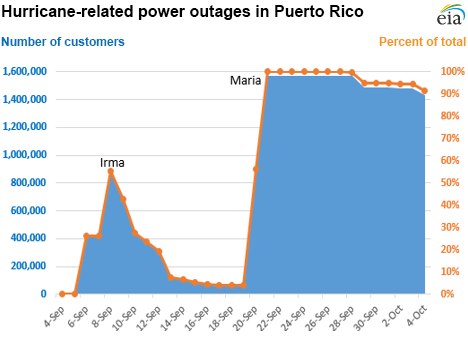 Source: U.S. Department of Energy, Situation Reports
Source: U.S. Department of Energy, Situation Reports
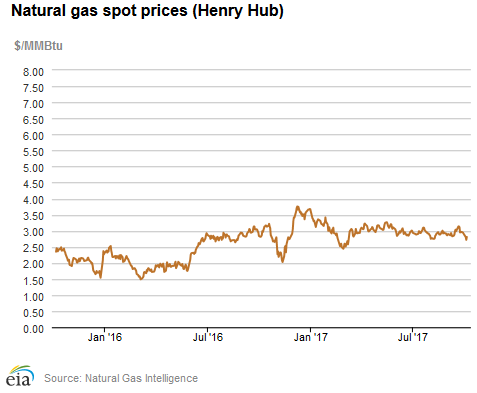
| Spot Prices ($/MMBtu) | Thu, 28-Sep |
Fri, 29-Sep |
Mon, 02-Oct |
Tue, 03-Oct |
Wed, 04-Oct |
|---|---|---|---|---|---|
| Henry Hub |
2.92 |
2.89 |
2.81 |
2.72 |
2.81 |
| New York |
1.21 |
1.52 |
1.87 |
2.44 |
2.78 |
| Chicago |
2.80 |
2.72 |
2.63 |
2.55 |
2.71 |
| Cal. Comp. Avg.* |
2.73 |
2.65 |
2.70 |
2.64 |
2.74 |
| Futures ($/MMBtu) | |||||
| November Contract | 3.017 |
3.007 |
2.916 |
2.895 |
2.940 |
| December Contract |
3.184 |
3.181 |
3.106 |
3.085 |
3.122 |
| *Avg. of NGI's reported prices for: Malin, PG&E Citygate, and Southern California Border Avg. | |||||
| Source: NGI's Daily Gas Price Index | |||||
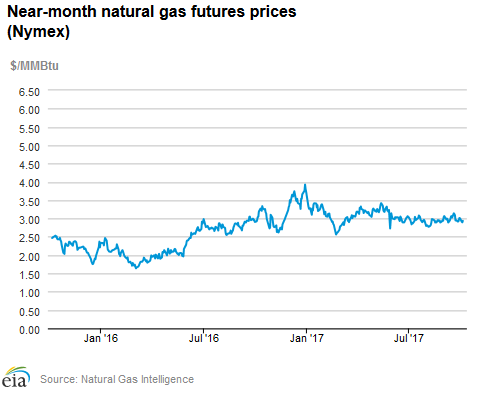
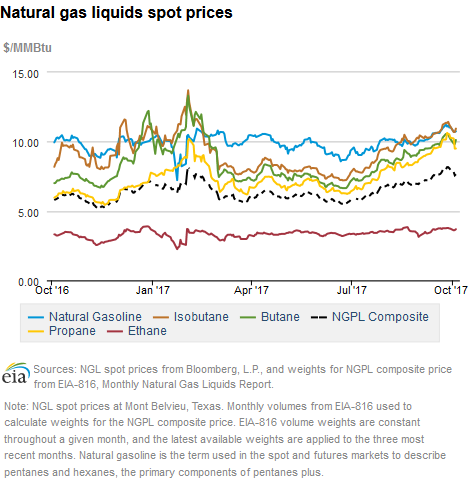
| U.S. natural gas supply - Gas Week: (9/28/17 - 10/4/17) | |||
|---|---|---|---|
Average daily values (Bcf/d): |
|||
this week |
last week |
last year |
|
| Marketed production | 82.6 |
83.1 |
78.8 |
| Dry production | 73.9 |
74.3 |
70.5 |
| Net Canada imports | 5.8 |
5.7 |
6.3 |
| LNG pipeline deliveries | 0.1 |
0.1 |
0.1 |
| Total supply | 79.7 |
80.0 |
76.9 |
|
Source: OPIS PointLogic Energy, an IHS Company | |||
| U.S. natural gas consumption - Gas Week: (9/28/17 - 10/4/17) | |||
|---|---|---|---|
Average daily values (Bcf/d): |
|||
this week |
last week |
last year |
|
| U.S. consumption | 52.7 |
61.4 |
51.9 |
| Power | 25.7 |
33.9 |
25.1 |
| Industrial | 19.8 |
19.4 |
19.6 |
| Residential/commercial | 7.1 |
8.1 |
7.2 |
| Mexico exports | 4.2 |
4.2 |
4.0 |
| Pipeline fuel use/losses | 5.8 |
6.8 |
5.7 |
| LNG pipeline receipts | 2.0 |
2.2 |
0.0 |
| Total demand | 64.7 |
74.6 |
61.7 |
|
Source: OPIS PointLogic Energy, an IHS Company | |||
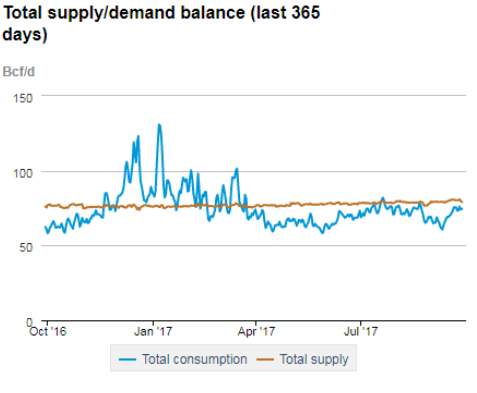
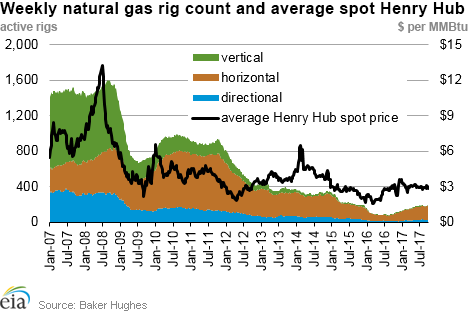
| Rigs | |||
|---|---|---|---|
Fri, September 29, 2017 |
Change from |
||
last week |
last year |
||
| Oil rigs | 750 |
0.8% |
76.5% |
| Natural gas rigs | 189 |
-0.5% |
96.9% |
| Note: Excludes any miscellaneous rigs | |||
| Rig numbers by type | |||
|---|---|---|---|
Fri, September 29, 2017 |
Change from |
||
last week |
last year |
||
| Vertical | 64 |
-5.9% |
0.0% |
| Horizontal | 794 |
0.5% |
95.1% |
| Directional | 82 |
6.5% |
60.8% |
| Source: Baker Hughes Inc. | |||
| Working gas in underground storage | ||||
|---|---|---|---|---|
Stocks billion cubic feet (Bcf) |
||||
| Region | 2017-09-29 |
2017-09-22 |
change |
|
| East | 861 |
848 |
13 |
|
| Midwest | 989 |
964 |
25 |
|
| Mountain | 220 |
217 |
3 |
|
| Pacific | 311 |
307 |
4 |
|
| South Central | 1,127 |
1,130 |
-3 |
|
| Total | 3,508 |
3,466 |
42 |
|
| Source: U.S. Energy Information Administration | ||||
| Working gas in underground storage | |||||
|---|---|---|---|---|---|
Historical comparisons |
|||||
Year ago (9/29/16) |
5-year average (2012-2016) |
||||
| Region | Stocks (Bcf) |
% change |
Stocks (Bcf) |
% change |
|
| East | 895 |
-3.8 |
861 |
0.0 |
|
| Midwest | 1,041 |
-5.0 |
989 |
0.0 |
|
| Mountain | 236 |
-6.8 |
206 |
6.8 |
|
| Pacific | 318 |
-2.2 |
343 |
-9.3 |
|
| South Central | 1,178 |
-4.3 |
1,117 |
0.9 |
|
| Total | 3,669 |
-4.4 |
3,516 |
-0.2 |
|
| Source: U.S. Energy Information Administration | |||||
| Temperature – heating & cooling degree days (week ending Sep 28) | ||||||||
|---|---|---|---|---|---|---|---|---|
HDD deviation from: |
CDD deviation from: |
|||||||
| Region | HDD Current |
normal |
last year |
CDD Current |
normal |
last year |
||
| New England | 3 |
-48 |
-11 |
41 |
40 |
23 |
||
| Middle Atlantic | 1 |
-40 |
-12 |
51 |
45 |
31 |
||
| E N Central | 7 |
-37 |
-4 |
63 |
57 |
33 |
||
| W N Central | 22 |
-24 |
3 |
41 |
31 |
4 |
||
| South Atlantic | 0 |
-16 |
0 |
84 |
35 |
0 |
||
| E S Central | 0 |
-16 |
0 |
76 |
42 |
-10 |
||
| W S Central | 1 |
-3 |
1 |
93 |
30 |
-2 |
||
| Mountain | 75 |
26 |
45 |
12 |
-17 |
-13 |
||
| Pacific | 17 |
1 |
11 |
16 |
-6 |
-23 |
||
| United States | 12 |
-19 |
3 |
56 |
30 |
6 |
||
|
Note: HDD = heating degree day; CDD = cooling degree day Source: National Oceanic and Atmospheric Administration | ||||||||
Average temperature (°F)
7-Day Mean ending Sep 28, 2017
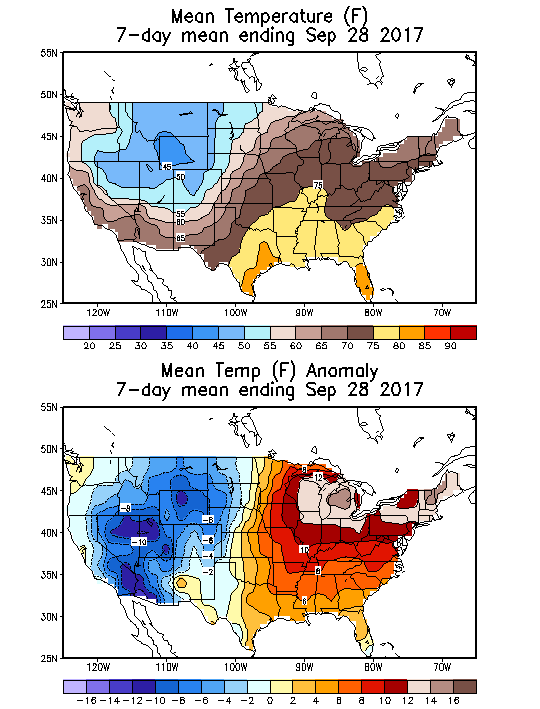
Source: NOAA National Weather Service
Deviation between average and normal (°F)
7-Day Mean ending Sep 28, 2017

Source: NOAA National Weather Service

